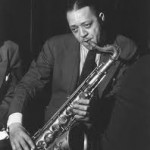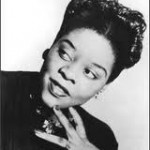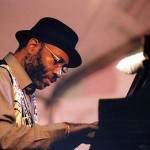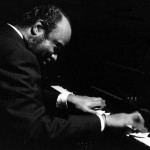Over the past few months the Independent Ear has featured conversations with some of today’s Brooklyn jazz movers & shakers, as well as a series of conversations on the legendary East. In this installment we journey back to the mid-1950s, a time when Brooklyn reputedly had a hotter jazz club scene than much – if not all – of Manhattan.
Recalling our Independent Ear conversation a few months ago with proto-rapper and hip hop scenester pioneer Fab Five Freddy, he spoke with great excitement about a group of jazz hipsters and scene makers who would gather to play chess, discuss world politics, and spin jazz records. Those gentlemen of jazz fandom included Fab’s dad Freddy Braithwaite, Sr., sculptor Jimmy Gittens, and Jimmy Morton. Randy Weston spoke often of this group of black jazz fans during the course of the many interviews for our book African Rhythms. In ’98 when I worked with Randy Weston to re-create his classic suite “Uhuru Afrika” on the stage of the historic Majestic Theater on Fulton Street, part of that project included a panel discussion with a group of Brooklyn jazz vets – including Jimmy Morton – and the walls were adorned with several blow-ups of Jimmy Morton’s photos from Brooklyn jazz haunts. These included a rare shot of Miles Davis, Thelonious Monk, Charles Mingus, Max Roach, and Etta Jones onstage together – noted also for being in color, which was unusual for the times.
When we began our ongoing Brooklyn jazz project for the Weeksville Heritage Center, Jimmy Morton was at the top of our interview list. One mild afternoon last winter we tracked the affable Mr. Morton down at his comfortable Queens abode. Now living in retirement Jimmy Morton still makes his share of jazz gigs and remains active. He proved once again that often the most vivid insights into a jazz scene come not only from those who make the music, but also from those who partake of that music.
Interview begins with subject showing us his classic jazz photo collection on his walls of photos he took at jazz clubs in Brooklyn.
We’re looking at one of your photos; please tell us about this particular photo.
Jimmy Morton: This was taken at Tony’s (in Brooklyn), and its Max Roach, Miles Davis, Gigi Gryce, Charles Mingus.

Takes us into another room of his apartment with an array of his photos.
This is Kenny Dorham, Art Farmer…
These are all from Tony’s?
These are all from Tony’s… except one.
It was called Tony’s Grand Dean?
Yeah. Did you read the book, Thelonious Monk – An American Original?
Robin Kelley’s book.
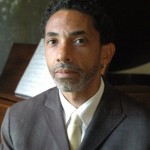
Thelonious Monk biographer Robin D.G. Kelley
He did the research and he found this ad from a 1954 Amsterdam News, and it says “Jimmy Morton, the fabulous MC.” He was looking for an article about Monk, and the reason he couldn’t find any is because Monk’s cabaret license had been taken away. So, although [Monk] was playing at Tony’s, [Tony’s] could not advertise [Monk].
How often did Monk play at Tony’s?
Very often, because we took him whether he had his cabaret license or not.
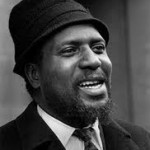
Was Monk using Willie Jones on drums at that time?
Yeah [shows photo of Willie Jones performing with Monk.]
Re-viewing the Ken Burns “Jazz” series via DVD (more on that in a forthcoming reassessment) I noticed the omission of Monk’s many nights performing undercover in Brooklyn when he lost his cabaret card. The film suggests Monk simply sat out the ban at his Manhattan home.
So Monk played at Tony’s a lot?
Yeah. I lived in Manhattan at that time and I drove him home a lot of times because I was about the only one going to Tony’s that didn’t live in Brooklyn.
…Displays photos he took at Tony’s with Carmen McRae, Arthur Taylor…
The one next to Arthur Taylor is a singer who sounded so much like Billie Holiday it’s probably why she never became anybody; her name was Billie Stewart. This other one is Etta Jones.
Who’s playing with Etta Jones in this picture?
Monk, but there’s a story behind that: Wynton Kelly stopped by in his Army khakis at the time and Etta pleaded with him, saying, and “you know how trying it is to sing with Monk.” She said, “Please play for me.” And Wynton Kelly not only played for her when she asked him to, but he played for her for the rest of the night. We had to figure out a way to pay him because we had already paid Monk. That’s Scoby Stroman dancing, with Leroy Applin; that’s Charlie Rouse behind him and Arthur Taylor behind him…
Tony’s was located at the corner of Grand & Dean Streets?
Grand Avenue and Dean Street; the building is still there, but it’s nothing [presently]. It was a local bar. In Robin’s book he refers to it as a small, black-owned café. We’ve got a friend named Vincent Jones, we used to call him Zandu, if he saw this article he would go crazy, because first of all it was owned by Italians named Bordello; in fact Roger Bordello had a liquor store on Bergen Street between Grand and the next street over.
Vincent Jones knew this family, and he was the one who talked them into letting Tony’s be a jazz spot, and Vincent was the one who brought all the acts in. He was a dancer, and they used to bring him out onstage in a coffin. He had a partner that would be dancing and she would dance and he would come out of the coffin. He used to get mad at me because I was taking all those pictures of young musicians, “and you never took any pictures of my act.” I loved the act, but I never took any pictures of it.
When you talk about jazz, most people start talking about Harlem. There was a time when I believe there were more jazz clubs in Brooklyn than there were in Manhattan. [Saxophonist] Bilal [Abdurahman]’s book [In The Key of Me] lists 24 Brooklyn jazz clubs, and I think Tony’s is included.
I’ll tell you how Tony’s happened. This same Vincent I was telling you about, he was heavily involved with Tony’s. There was a fellow named Freddy Brathwaite, we were very good friends. A Brooklyn artist named Jimmy Gittins was also involved, and between Vincent, Freddy and Jimmy, they ran Tony’s. I was in law school at the time and when I shoulda been home studying; I was hanging out at Tony’s listening to the music. And though it only cost a dollar to go in, I’d never pay because I knew those guys.
Most bands announced themselves, but every now and then you’d get a band that would say ‘I’m not supposed to be announcing anything.’ So they said to me, ‘you don’t pay when you come in, so announce the bands.’ And that’s how I became an itinerant MC, simple as that. I started announcing the bands and then people used me for other things. It all started by me going to Tony’s and knowing the guys running Tony’s, and they started me MCing.
When you were coming up in Brooklyn, did you hang out with musicians?
No, because at my early stages, when I was a kid, I didn’t know any musicians. This didn’t happen until I was almost a teenager and I started listening to jazz. I tuned in on the AM radio and you’d get certain big bands broadcasting. I was always a Benny Goodman fan, and Artie Shaw. Most of the big bands were white bands; the ones that could swing really were good bands.
So you came up through the big bands?
Yes.
What about in the 1940s when people like Max Roach, Dizzy Gillespie, Charlie Parker, started experimenting with the music, did you get into that new thing?
Yeah, well the Putnam Central, on Putnam Avenue… Charlie Mingus and Max Roach had a studio in that building where the Putnam Central [jazz club] was, and they were among few musicians who wanted to put out their own records. Mingus and Max started producing their own records.
That was Debut Records, right?
That’s correct.
So Max and Mingus were actually making records in the same building as the Putnam Central club?

Yes, their studio was upstairs over the club. That building belonged to some union, I think it’s still there and still functioning.
Since the studio was upstairs over the club, were they recording musicians who were playing in the club?
I don’t think so, I think they did mostly their own music – between Mingus and Max, they did their own thing. There was a group called The Greatest Quintet Ever, with Mingus and Max [plus Monk and Bud Powell], and when Mingus heard the original recording he felt that the bass line was underplayed – he didn’t hear the bass enough. So he took the masters to his studio and when you hear that record now, the bass line is refined; they were able to do that because they had their studio.
Describe what Tony’s looked like physically.
Tony’s was a local bar that had a small kitchen and a back room, nothing fancy or pretty about it. Most of the pictures you just saw was the back room at Tony’s. These pictures you just saw were originally slides, and the original slides Fab Five Freddy has.
When these performances were happening at Tony’s, what kind of audience did they get there?
They were mostly Brooklynites, mostly local people came. Every now and then people from Harlem might come by. There were French jazz people who heard about Tony’s – Andre Renard would come by. It was unusual for white people to be there. Usually I would end up questioning them, wondering how they got there. There was a popular columnist at that time called Dorothy Kilgallen, and she began to mention Tony’s in her column, and all kinds of strange people began showing up that ordinarily wouldn’t even be there. She mentioned it in her column and it was getting to be known. Tony’s was a local Brooklyn club, but when it got to be more than that it disbanded, which I never understood, when they could have kept going.
How long did Tony’s operate?
I went there for the first time in 1953.
What year did Tony’s open?
It opened about 1952-53 and stayed around until about ’55.
What year did you start MCing at Tony’s?
I started about 1953. What was strange about those times is that most of the famous jazz people were almost all into drugs; so what would happen at the intermission, I couldn’t find anybody. I’d be running around… I knew Brooklyn because I was born and raised in Brooklyn; I’d be running up and down Dean Street looking in hallways, trying to get the musicians back to work after the intermission was over.
What were you doing professionally at the time?
One of the things I blew by hanging at Tony’s… I was in law school, I was going to St. John’s at that time, and I flunked out of law school because when I shoulda been studying, I was jazzing! But as far as employment was concerned, I was a welfare investigator, I was an investigator for the department of hospitals at Bellevue, I was a corrections officer at Rikers Island, and I finally wound up working at the [state] Supreme Court where I retired after 28 years in Bronx County.
When you were MCing at Tony’s, describe how you would introduce the bands.
I met Etta Jones when Art Blakey brought her to Tony’s, and we already had a singer at the time, and I was very upset; I said “who’s this person, we didn’t hire her…”, until I heard her sing! When I heard [Etta Jones] sing, I said we didn’t need the first guy that we hired… But I used to introduce [Etta Jones] and I would say “hush, it’s the bewitching hour… you’re about to be inundated with the golden tones of Etta Jones…” That’s how I used to bring her on.
But as far as the jazz went, Oscar Pettiford sometimes sat in, and I’d introduce Charlie Mingus and I’d say “…Charlie, your work is cut out for you because Oscar Pettiford just played, and you’re playing behind him…” Mingus had a strange attitude, he’d say “…Man, he didn’t even play a bass…”, Pettiford played a cello at the time. Mingus was hard to get along with – he was a good musician – but I didn’t think he was a nice person, we always were fighting about everything.
Max [Roach] I knew from the time he played in the band at Concord Baptist Church, he started way back in Brooklyn, and we always had a good relationship. In fact, towards the end of his life I visited him at the assisted living place in Brooklyn; I was there when Gil Noble recorded his “Like it Is” show, and Randy [Weston] was playing the piano for Max, and Max looked like he was almost nodding out.
How many nights a week did Tony’s have performances?
Friday, Saturday, and Sunday… In fact, that ad that’s on the wall that was Easter Sunday, and instead of the usual time I think we started at 5:00 p.m. It was really only three nights.
How many sets a night?
Maybe three: 8:00, 10:00, and a final set at 12:00.
Where would the musicians go after their gigs at Tony’s?
They had a place on Nostrand Avenue, a chain coffee place whose name escapes me now, but everybody used to go there because it was open at all hours and you could get food at a reasonable price, so that was a hangout. There were people in Brooklyn who the musicians knew and they would go to their houses after the gig.
When we were working on his book Randy told me a story about bringing Monk to your place about 3:00 a.m. to use your piano.
My sister was a church organist, and I was living with her at that time and the piano was hers. Randy knew there was a piano there and he brought Monk, and Max because there was a piano there. When it was over my sister was so impressed that Monk was there!
What are some of your fondest memories of nights you spent at Tony’s?
I’m sure Randy [Weston] told you about it, but they had a fight there once that was almost like a movie scene. What Randy didn’t know is how the fight started. It started because they put me on the door – I was never on the door – if I was on the door all the time I would have known who the local gangsters were. The fact that I was not on the door usually, I didn’t know the local gangsters, and they wanted to come in without paying and I wasn’t going to allow that. So we got into it at the door, and it grew and grew until the chairs were flying … the place looked so bad I was amazed when I came back the next night and the place had been put back together; they had repaired the chairs… all the damage that had been done the night before – as bad as this fight was, we didn’t miss one night! I remember the bass player, who I think was Mingus, was holding up his bass, protecting his bass. I think Monk kept playing.
[According to Weston’s account, despite fist fights and wrestling matches all around the club, chairs flying and the whole riotous bit, Monk never batted an eye and just kept right on playing despite this maelstrom around him.]
I drove [Monk] home a couple of times and we talked about things other than music. As strange as everybody thought he was, I thought he was very informed about most things. He could talk about anything you wanted to talk about , IF he felt like talking, because if he didn’t feel like talking you got nothing out of him.
Did you do any MCing at any other places in Brooklyn?
Yes, there was a place on Eastern Parkway and Bedford Avenue – I think they called it Town and Country, and I MC’ed there. Based on what happened at Tony’s, I became an itinerant MC. I would be MC’ing at all kinds of places (laughs).
How would you say the jazz clubs in Brooklyn were different from what was going on in Harlem?
Because I’ve been to the Baby Grand in Manhattan, and the Lenox Lounge in Manhattan – I just believe the Brooklyn audiences were different. I used to say the guys in Brooklyn wore their hats different than the guys in Manhattan. You could almost tell the difference from the way they broke their hats down; they just had a style that was Brooklyn, and Harlem had a style that was Harlem. And they had an antipathy towards each other; they’d say ‘that cat is from Harlem’, and they’d say it as if he was in trouble [laughs]. Or the guys from Harlem would say ‘this dude is from Brooklyn’…
I MC’d the thing in Prospect Park, the thing called Celebrate Brooklyn, and Eubie Blake was in the audience; some of the music was his music. They took the mic to Eubie and asked if he had any comments about the shows, and he said he felt there should be more mention of the people who wrote the tunes. So I told him, you may not have been listening, but I had been mentioning the authors – and especially his tunes. I thought it was great for him to just be there.
Who were some of the other noted musicians playing in Brooklyn at that time?
JM: The Modern Jazz Quartet came to Tony’s – with Milt Jackson, John Lewis… I used to have a hassle with John Lewis because he didn’t like the way I introduced the Modern Jazz Quartet. He said ‘this is not a baseball team.’ I said, I don’t tell you how to play the piano, don’t tell me how to MC. Everybody that was anybody in jazz, in the 50s, came through Tony’s, they made an appearance at Tony’s. Mingus had a way that he wanted to be introduced, but most others I was free to do whatever I wanted to do. I didn’t disrespect anybody.
What other involvement have you had with jazz in Brooklyn? Were you a member of any of the listening clubs or jazz enthusiasts organizations in Brooklyn?
No, but as of now I’m involved with the Andy Kirk Research Foundation with Donald Sangster; he’s the chairman and I’m one of the vice chairmen, and I’m a letter writer.
What kind of work is the Andy Kirk Foundation involved in?
We’re trying to get jazz as part of the curriculum in the school. In fact we went to Bilal Abdurahman’s widow’s house in an attempt to get her to let us use his book. Bilal’s book needed editing as far as correct presentation is concerned, but the information in it is invaluable.
When I was coming up, most of the schools had some kind of music program. The first classical music I heard was in school, and I don’t hear any talk about music in schools now, and that’s one of the things the foundation is trying to do is put music in the school system. Students all should have a knowledge of the music, who played it, and where it came from. One of the things the Andy Kirk Research Foundation wants to do is preserve the history of the music. One of the things we’ve tried to get started is an archives. We had meetings at Medgar Evers [College] talking about these archives. Ray Abrams’ brother was saying how most of Ray’s stuff went to York College in Queens, and we said ‘Ray Abrams is a Brooklyn person, everything about him is Brooklyn, and it should be in Brooklyn.’ Medgar Evers sounded like they were listening, but nothing ever happened.
What about the Willie Jones Foundation?
He’s one of the reasons I got involved with Medgar Evers [College]. I thought the archives was going to come to pass, and Willie Jones was heavily involved with Medgar Evers and the then-president, who is no longer there. The president said he knew Willie Jones, he knew how active he was at one time, and he would have no objection to the archives being named after [Willie Jones]. So I felt like my reason for going there [Medgar Evers] had been accomplished. But the archives never became a fact. There was a lot of conversation that had Medgar Evers doing some building, on Bedford Avenue across from where they are now, they had some new construction going up, and they told us there would be some room set aside for the archives, but then we heard they didn’t have room for the archives. They had an architect map out all they were going to need for an archives, and the more I saw how much this was going to cost, the less I felt this was going to happen. And it never really happened.
What has become of the Willie Jones archives?
Ray Abrams stuff went to York College; his brother was going to do something about it if anything ever happened with Medgar Evers. In the midst of all of this he [Ray Abrams brother] died, so there was nobody pushing for this anymore. I gotta give Donald Sangster credit, he’s been trying since I’ve been involved with him to get the archives going. Wade Barnes, who has a band, has been talking about using the Slave Theater on Fulton Street, to do some things. Everybody is trying, but I don’t know who is succeeding. I give Sangster credit in that he doesn’t give up.
Since you have these classic photos of Brooklyn jazz, what about your own archives?
Whenever I hear about anybody writing – like Robin Kelley [Thelonious Monk book], and Fab Five being involved with Robin, I told him if he wanted to use any of my pictures he could use them, all I wanted was credit. So he gave me one of the books and inscribed it “Robin Kelley, with gratitude and respect.”
So where did Robin get your pictures?
From Fab Five [Freddy]. In the [Monk] book he talks about Willie Jones in Monk’s band.
Have you kept a lot of your photos and slides?
The originals are the ones you were looking at earlier; Fab Five has the slides.
How did Tony’s publicize their performances?
They had placards out front, and the regulars knew who was there. The time Art Blakey brought Etta Jones there, we already had a picture outside of who was going to be the singer appearing there. The budget was light and they couldn’t pay two singers, but once Etta started singing, she was the one who got paid.
Did the musicians who played at Tony’s play for the whole weekend, for weeks at a time, or what?
It would usually be for the weekend; whatever group they hired would be Friday, Saturday and Sunday. But of course since they only paid [union] scale, if they could find a better gig somewhere else, they went to the other gig.
Other than Tony’s and Putnam Central, which you mentioned, what are some of the other important Brooklyn jazz clubs?
The Continental on Nostrand Avenue; Kingston Lounge…
What was important about the Kingston Lounge?
Kingston Lounge was a class act. The Kingston Lounge was Rector Bailey’s spot, and they put on class shows. Most of the time when I went to the Kingston Lounge I was in the audience, not MC’ing. Elmo Hope was playing at the Continental and the legs of the piano stool were coming off the stage. I grabbed the legs and pushed it back up on stage and he never missed a note! The Crescent Lounge on Reed Avenue and Fulton Street; the Turbo Village was Halsey and Reed Avenue that was a nice jazz joint – not fancy, but quality jazz. The East…, I don’t know whether it was more political or musical. The Willoughby Temple, I think I saw Jackie McLean there, and there was an old Brooklyn bass player I grew up with named Franklin Skeete.
Do you have any other Brooklyn jazz memories you’d like to share with us?
The Arlington Inn had good local musicians that played there, but none of the big names. That’s about it… I still make it around if there’s something or someone I want to see.
I found that I usually got along with people; I tried not to be aggressive or abrasive, and I was very aware of what musicians were going through at that time – I know they were not being paid what they should have been paid, and sometimes gigs were few and far between, and I respected all of that and I treated them with respect.




